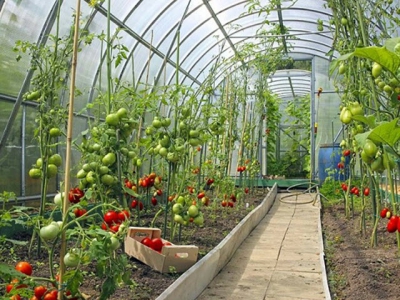Planning a Garden Greenhouse for Organic Gardening

Even a small unheated garden greenhouse can be put to good use all the year round. If you plan carefully, then you can have different flowers in bloom and different crops to harvest nearly every month from January to December.
Creating the right environment
Temperature, moisture at the roots, humidity, shelter, light intensity, and day length all combine to affect plant growth. In a greenhouse you can manipulate these factors to grow a wide range of plants, some from climates quite different from your own, but you must find out what each plant needs in order to thrive.
A greenhouse is useful for growing plants that simply find it too cold in the garden. For example, cucumbers and peppers growing outside may produce summer crops, but in cooler climates it is not hot enough for long enough for them to give a really worthwhile crop.
The greenhouse can be used similarly to advance or extend the season of hardy crops and flowers, or to provide shelter for blooms that come naturally in the short days of winter, such as late-flowering chrysanthemums. A greenhouse also keeps off the rain, so giving a chance to plants such as alpines that tolerate cold but not damp conditions.
Growing a mixed collection of plants means that you have to cater for their differing needs, but if you water carefully and make use of the different climates in the greenhouse — for example, the shady spots under the benching or draughty spots near the door — then there is no reason why they should not grow well together. The advantage is that different plants often have their own individual pests and diseases, so there is less chance of any one of them building up to an epidemic. You can also help to minimize this by planning a crop rotation.
Making the best use of the greenhouse
The space in a greenhouse is valuable, so try to make use of it at all levels, for example, by putting shade-loving plants under the staging or, perhaps, half-hardy flowers in hanging baskets.
Try also to make use of your greenhouse at all times. Most plants only need greenhouse protection for a few months of the year. At other times they might be put outside in pots or stored as dormant bulbs, and some will take only weeks to grow from seed. Thus, you could grow tender shrubs in large pots, so they can be moved outside in summer to make way for tender annuals. Bring on summer-sown crops like lettuce, parsley, and other salads in modules outside to fill the greenhouse border when tomatoes and cucumbers are over. Keep a diary of sowing, harvesting, and clearing dates to help you in the future.
Related news
 Cabbage disease black rot
Cabbage disease black rot Black rot (Xanthomonas campestris) is the most important cabbage disease. Thriving in warm, wet conditions, it is most active at 25°C to 30°C
 Preventing blackleg in cabbage
Preventing blackleg in cabbage Blackleg is a fungal disease that can be highly destructive. Fortunately, although there are no resistant varieties, it can be managed or prevented if you know
 Common Diseases of Greenhouse Plants
Common Diseases of Greenhouse Plants Various fungi and bacteria, Pythium sp., Phytophthora, and others which are common in garden soils contribute to this problem